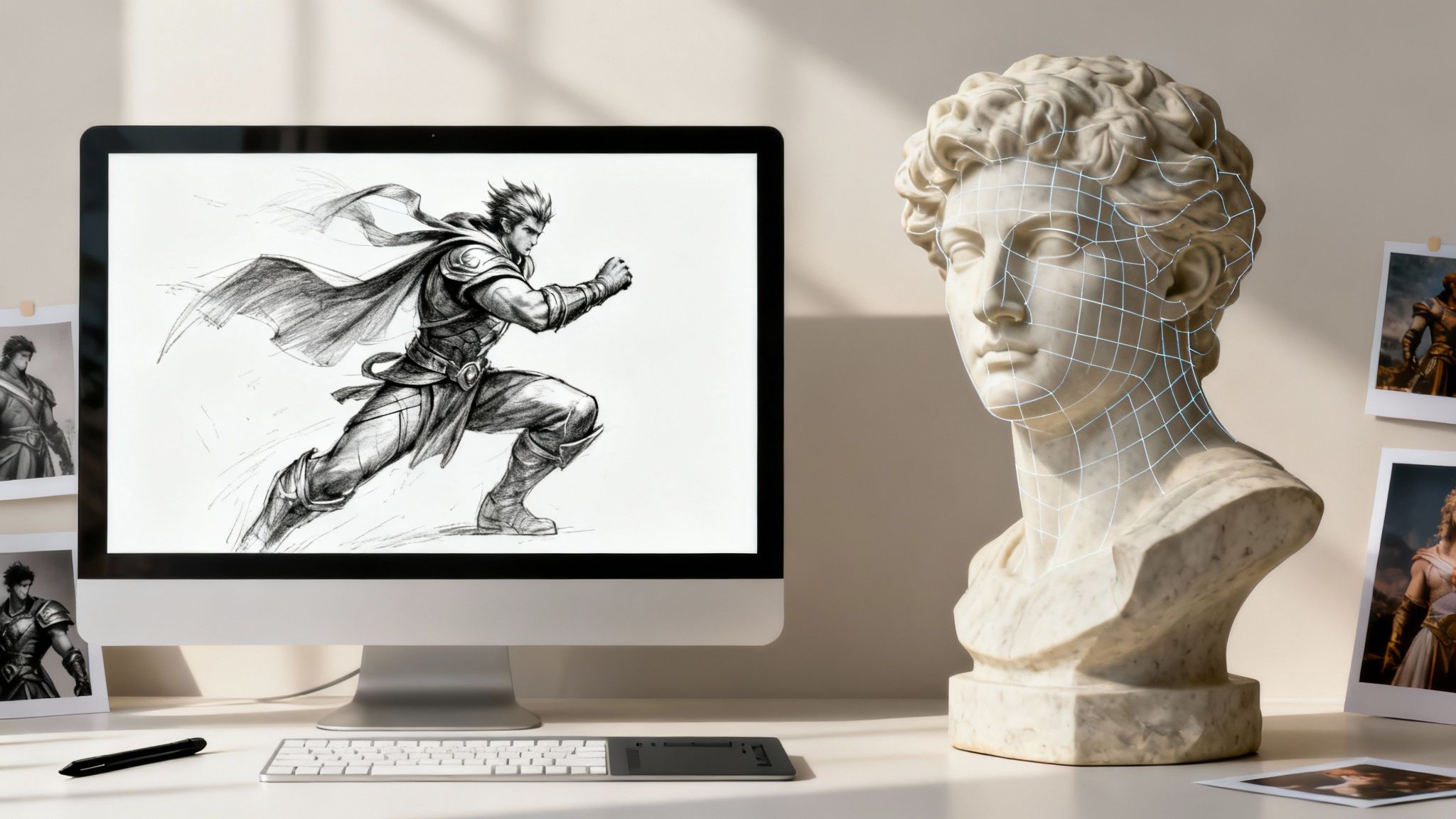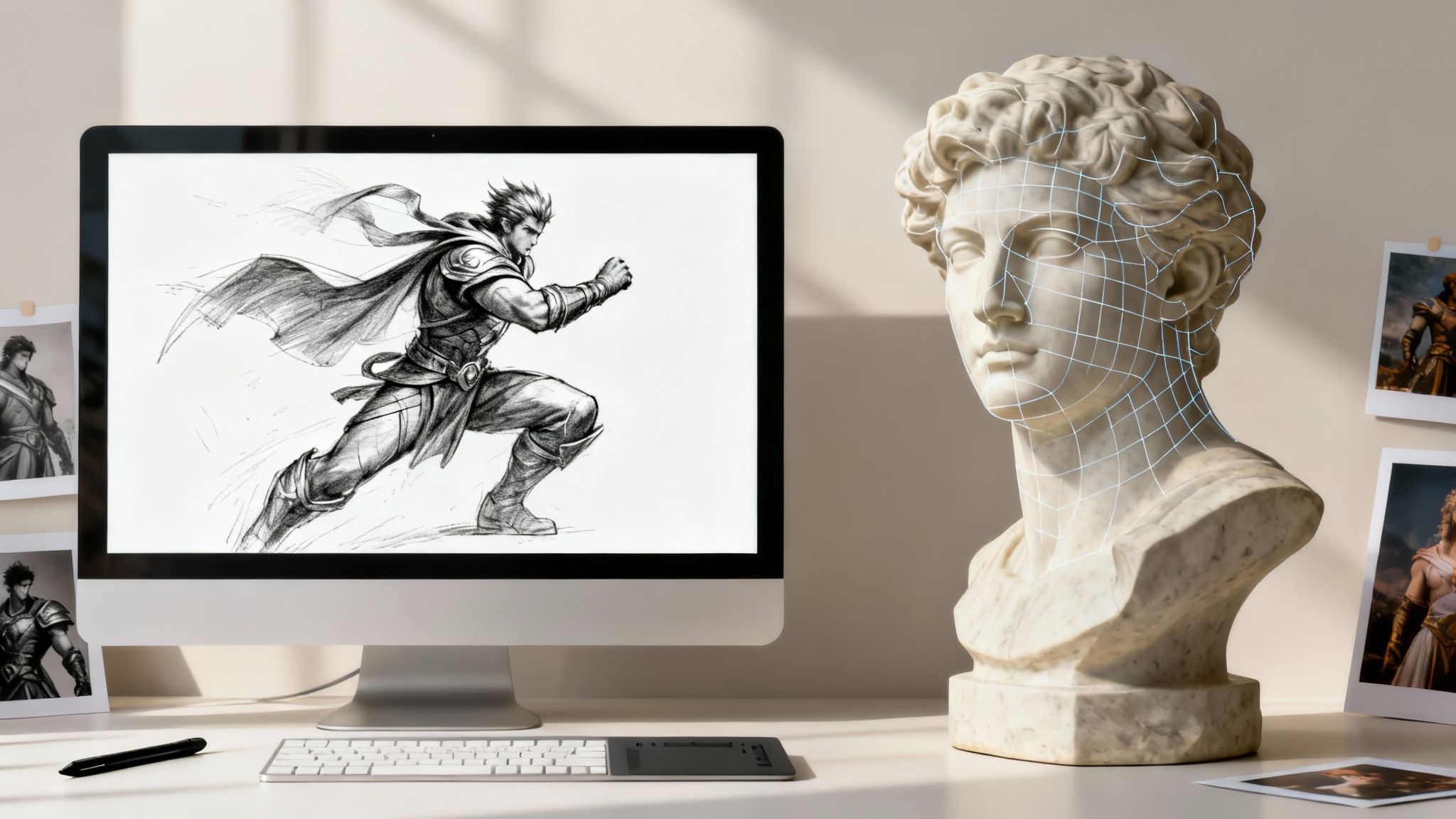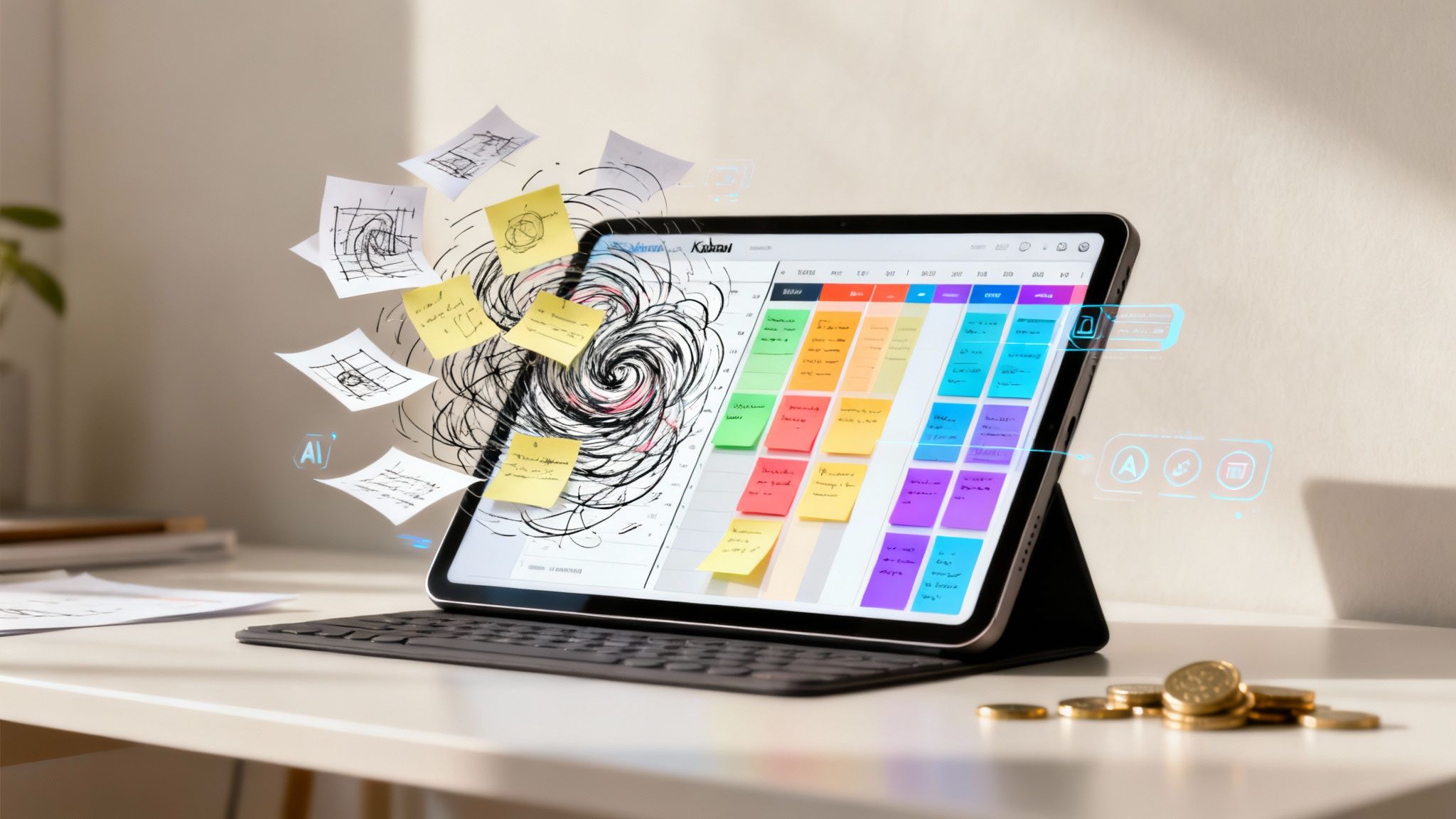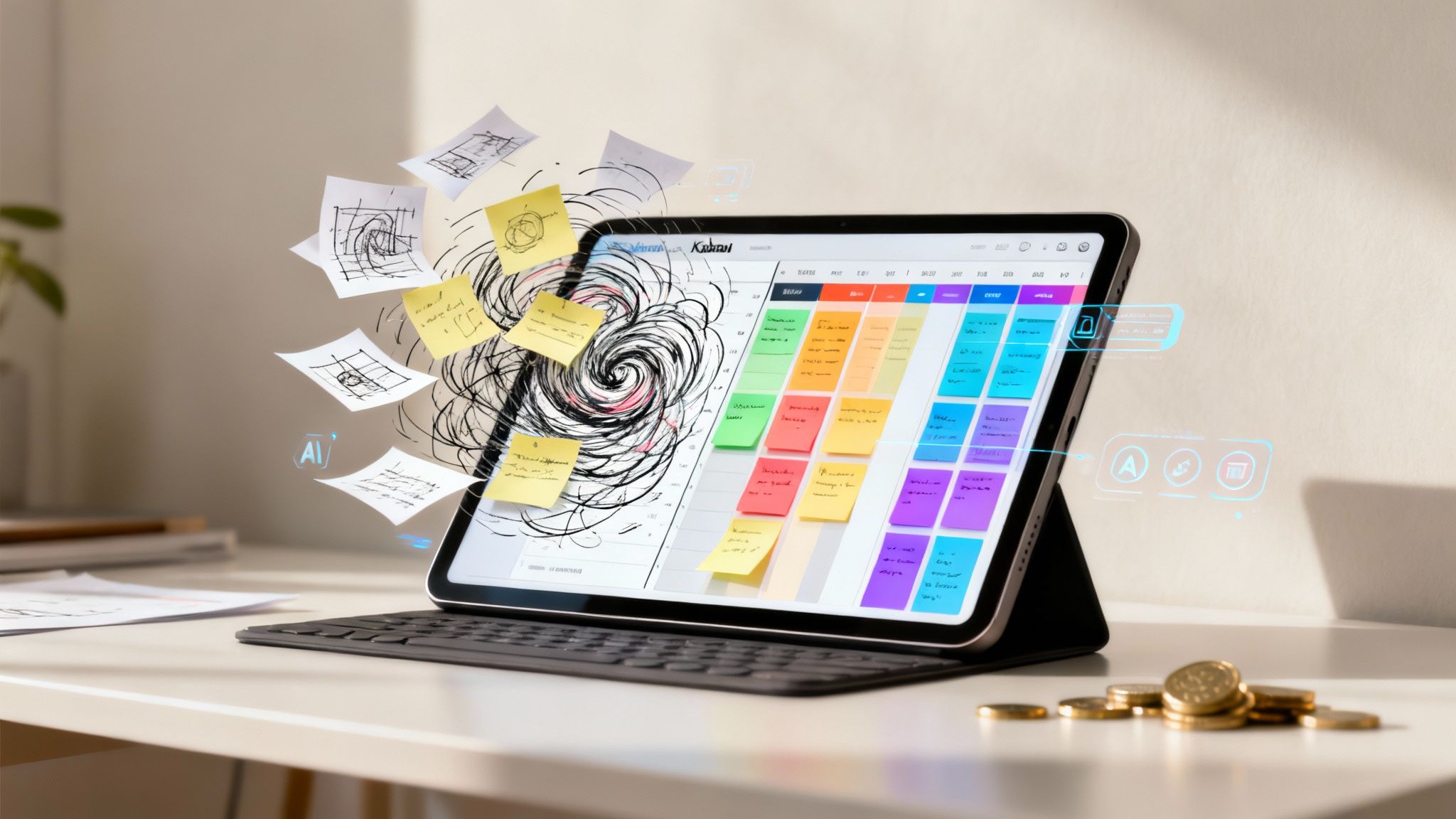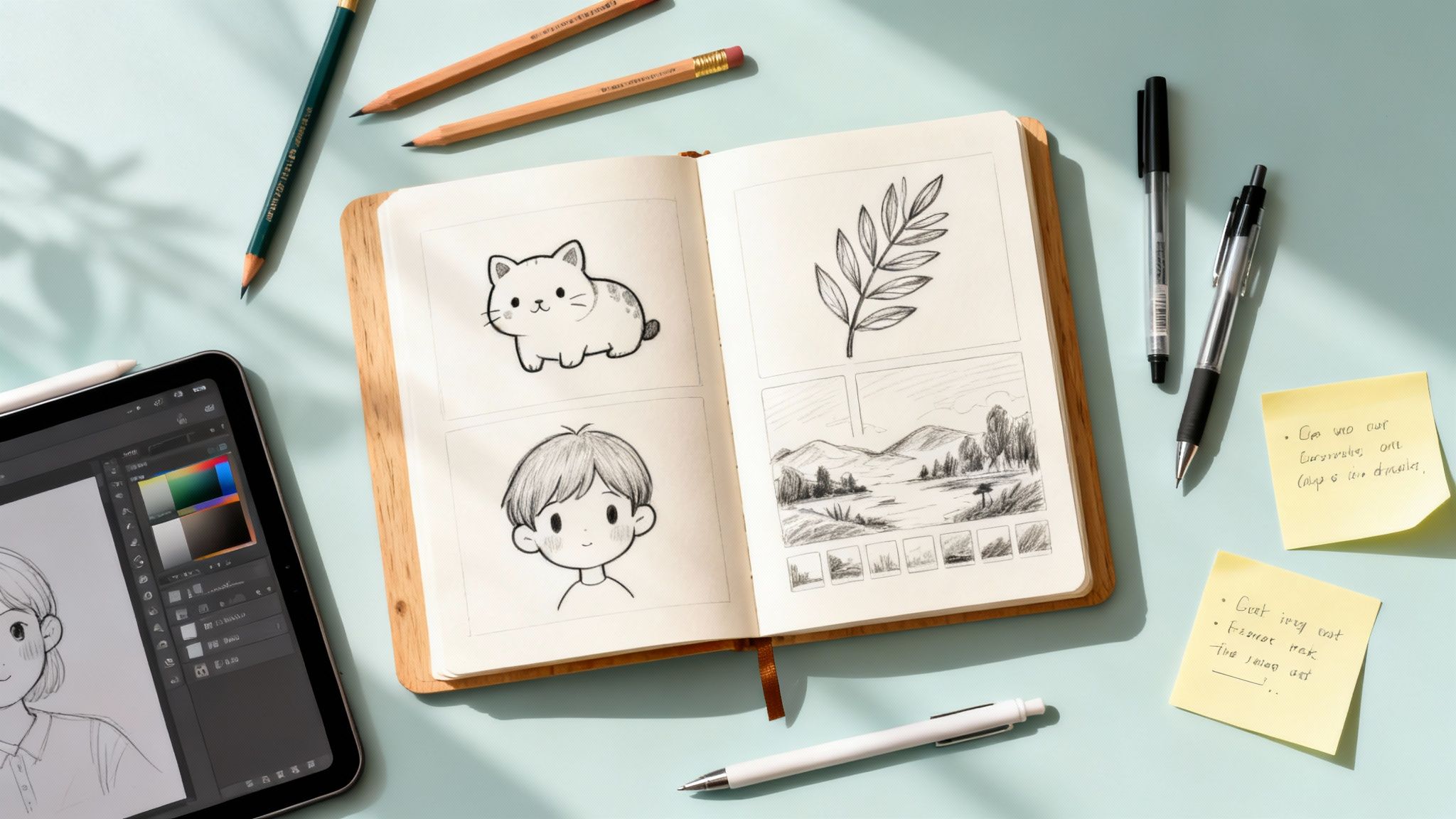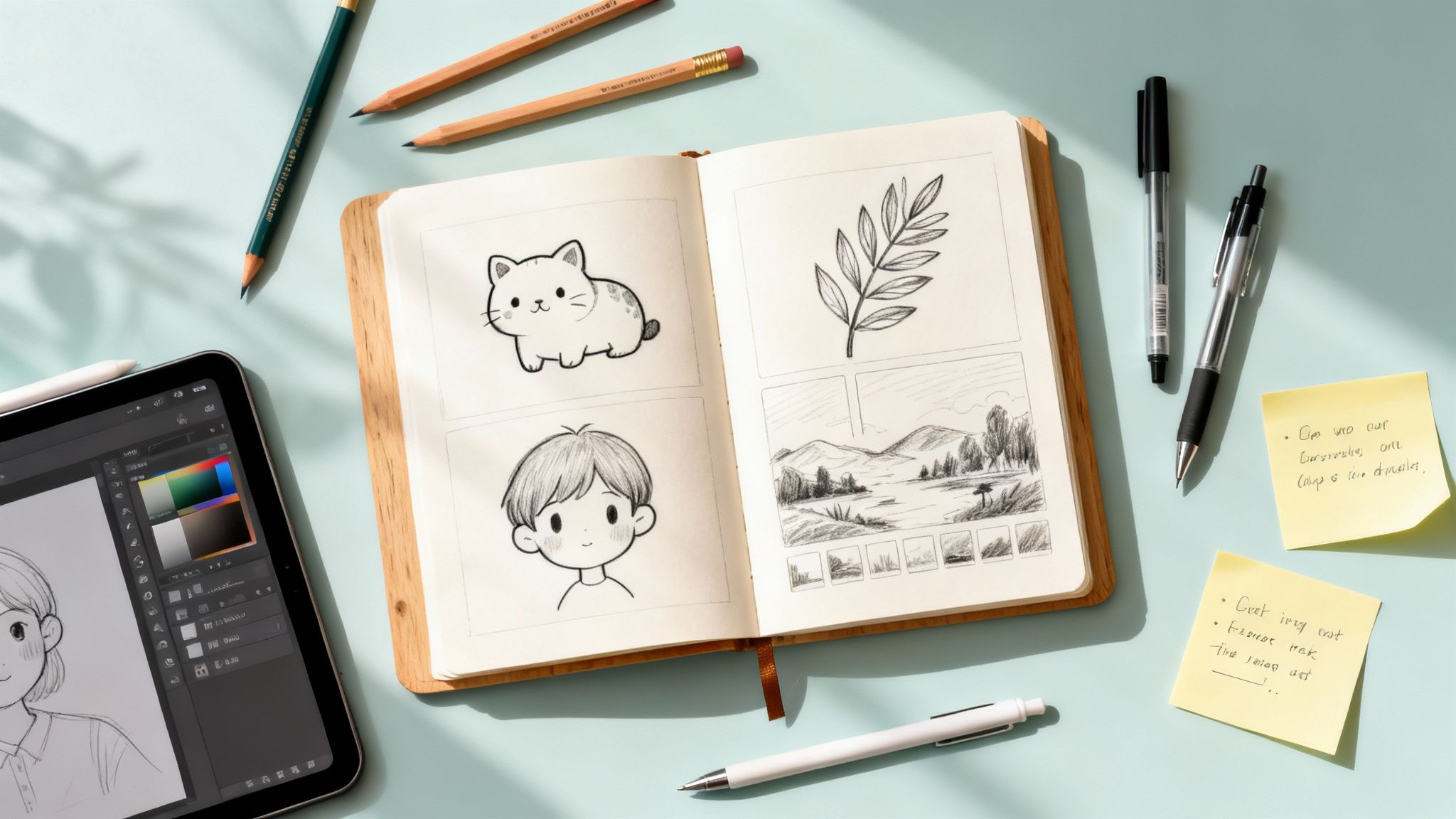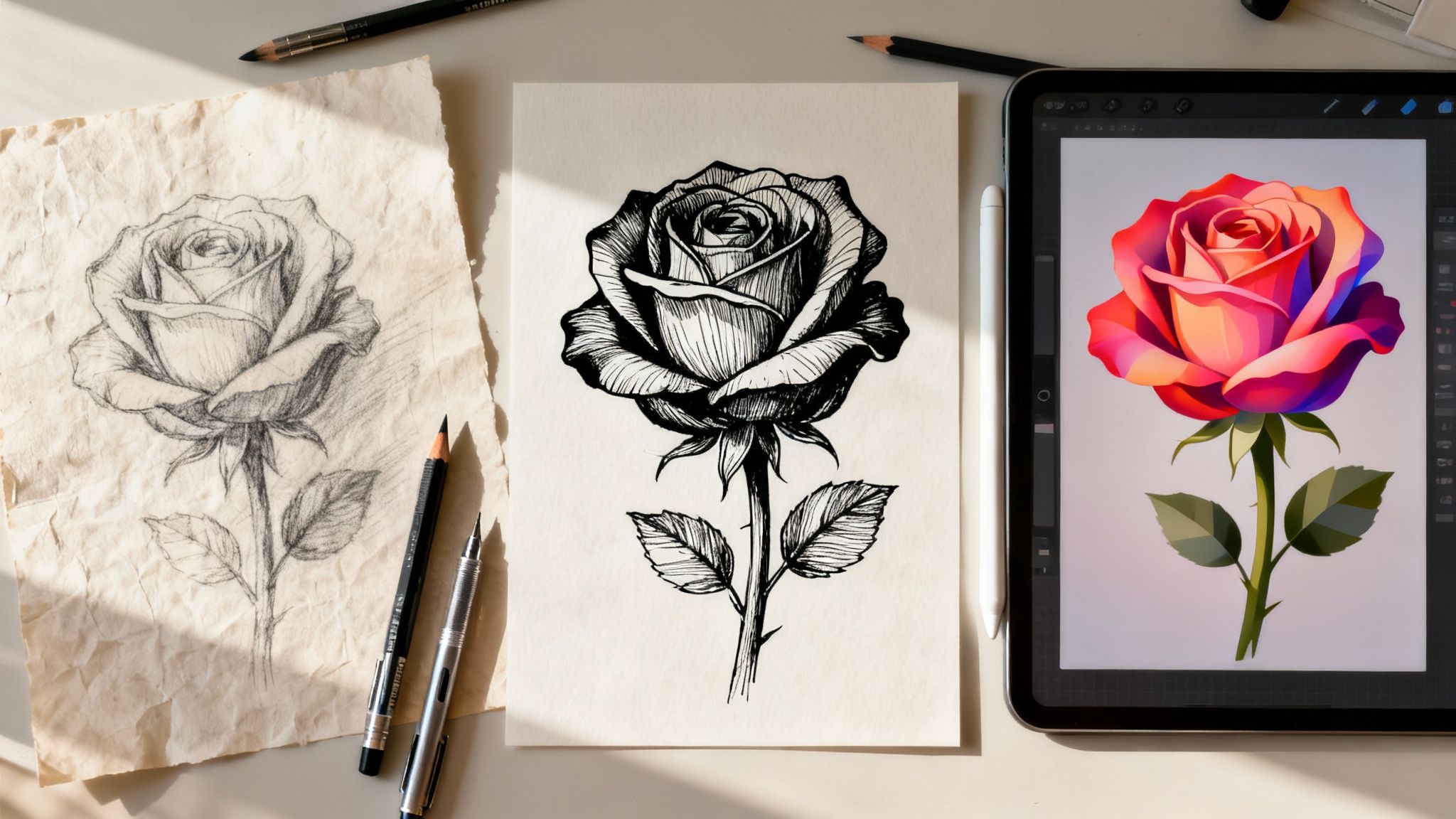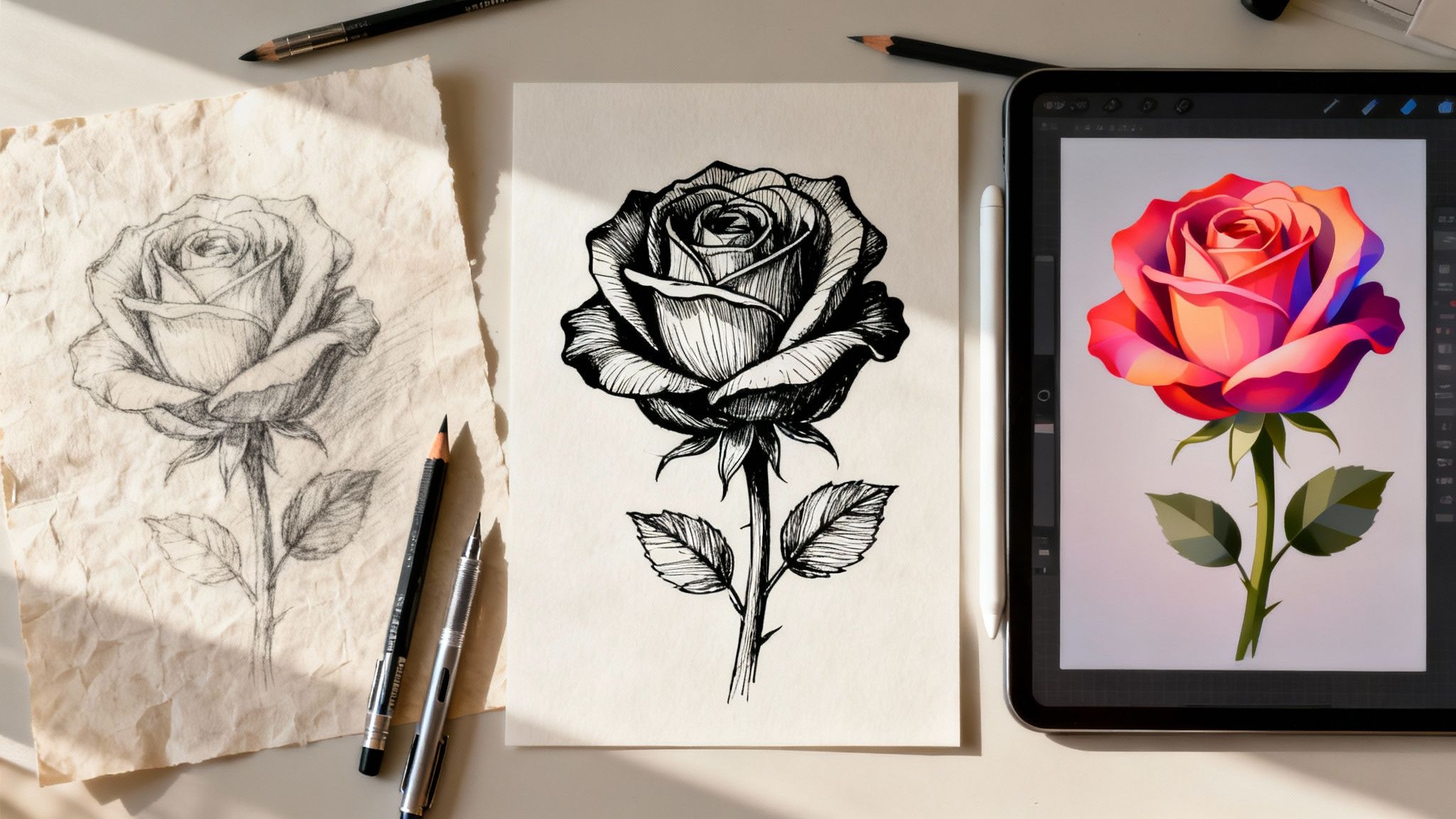Game character design is a sophisticated discipline that blends art, storytelling, and technology. It's the process of creating digital beings that are not only visually appealing but also resonate with players, serve the narrative, and function flawlessly within the game's technical constraints.
First, Define Your Character's Core Identity
Every memorable character begins as a well-defined concept, not just a drawing. Before launching into software or sculpting, it is crucial to establish the foundational work of building who the character is. This conceptual stage defines their identity, their role in the game world, and their core motivations. A strong foundation ensures that subsequent visual and technical decisions are coherent and purposeful.
This phase is about asking strategic questions, similar to how a writer would develop a profile for their protagonist.
- What’s their backstory? Where do they come from? What pivotal life events have shaped them? A character from a harsh, resource-scarce environment will look and behave differently than one from a technologically advanced, orderly society.
- What are their motivations? Effective characters have clear objectives. Are they seeking justice, redemption, power, or the protection of loved ones? This central drive informs their actions and provides an emotional anchor for the player.
- What's their personality? Are they a courageous but impulsive warrior? A methodical and cautious tactician? Perhaps a pragmatic and cynical operative? Defining key traits will guide everything from their facial expressions to their combat style.
To structure this process, we can break it down into core pillars. Consider these the essential elements to define before moving forward.
Core Pillars of Character Conceptualization
Once you have clear answers for each of these pillars, you have a solid blueprint. The design becomes a purposeful reflection of a well-defined individual, rather than an arbitrary collection of aesthetic ideas.
Weaving Narrative and Gameplay Together
A character’s identity must serve two functions: supporting the narrative and enhancing gameplay. The design needs to instantly communicate their role to the player. A large, heavily built figure with prominent shoulder armour suggests a "tank" or "bruiser," while a lean, agile character immediately signals a fast-moving scout or assassin.
This synergy makes a game feel intuitive. When a character's appearance aligns with their capabilities, the experience becomes more immersive and coherent. For example, in a game like NINJA GAIDEN 4, the art director, Tomoko Nishii, noted that the new protagonist, Yakumo, was intentionally designed with a slender frame to reflect his high-speed gameplay. This creates a clear visual distinction from the more powerful and muscular series veteran, Ryu Hayabusa, informing the player about their different playstyles at a glance.
A character's design is a visual contract with the player, setting expectations for the gameplay experience. When visuals and mechanics are aligned, the experience feels cohesive and believable.
Understanding Your Audience
Who is the intended audience for this game? The answer should significantly influence character design. Player demographics and cultural expectations can shape which character archetypes and playstyles will resonate. Market research often indicates that different demographics gravitate towards specific character types and gameplay mechanics.
By understanding your target players, you can create characters that not only fit within the game world but also connect with the people who will be playing. This connection fosters stronger emotional investment and makes the overall experience more memorable and engaging.
This foundational work—building a character from the inside out—is the most critical step. For a deeper dive into turning these ideas into initial visuals, check out our guide on creating compelling concept art for games. It’s the perfect next step.
Visualizing Your Character in 2D and 3D
With a solid concept established, the next stage is to bring your character to life visually. This is where abstract ideas—personality, backstory, abilities—are translated into tangible shapes, colours, and lines. It's a journey from a rough sketch to a game-ready 3D model, requiring a careful balance of artistic skill and technical proficiency.
The process often begins with silhouettes. A character’s outline is arguably their most important visual feature, as it's what players recognize instantly during fast-paced action or from a distance. A strong, unique silhouette makes a character immediately identifiable and prevents them from becoming lost in complex environments.
A recommended approach is to start by sketching dozens of rough, blacked-out shapes. Defer details and focus entirely on posture, proportions, and large forms—such as distinctive armour, a unique hairstyle, or unique appendages. Does the shape convey strength, agility, or intelligence? This early exploration is an efficient way to lay the groundwork for a memorable design.
From Silhouettes to Detailed Concepts
Once you've identified a few promising silhouettes, you can begin to layer in details and colour. This is an opportunity to use colour theory to reinforce the character’s personality. Warm reds and oranges can suggest aggression, while cool blues and greens might convey calmness or mystery. A limited, carefully chosen colour palette often appears more professional and cohesive than a chaotic mix of colours.
This is also the stage for exploring different costume variations, weapon designs, and facial expressions. The ultimate goal is to create a comprehensive concept sheet, often called a character turnaround. This document serves as the primary reference for the 3D artists.
Typically, it includes:
- Front, side, and back views of the character in a neutral T-pose or A-pose.
- Detailed callouts pointing out specific materials, textures, or complex gear.
- Facial expression studies to demonstrate their emotional range.
- Action poses that capture their personality and suggest their abilities.
The Leap into Digital Sculpting
With a detailed concept sheet approved, the process transitions from 2D to 3D, almost always starting with digital sculpting. Using software like ZBrush or Blender, an artist creates a high-poly model. This is akin to working with digital clay, where the focus is on achieving a perfect, highly detailed form without being constrained by technical limitations like polygon count.
A deep understanding of anatomy, form, and weight is essential here. Even for heavily stylized characters, a foundation in believable anatomy prevents them from feeling awkward or unconvincing. This high-poly sculpt will contain every detail: the subtle weave of fabric, minute scratches on armour, and fine facial wrinkles. These details are later "baked" onto the final, optimized game model.
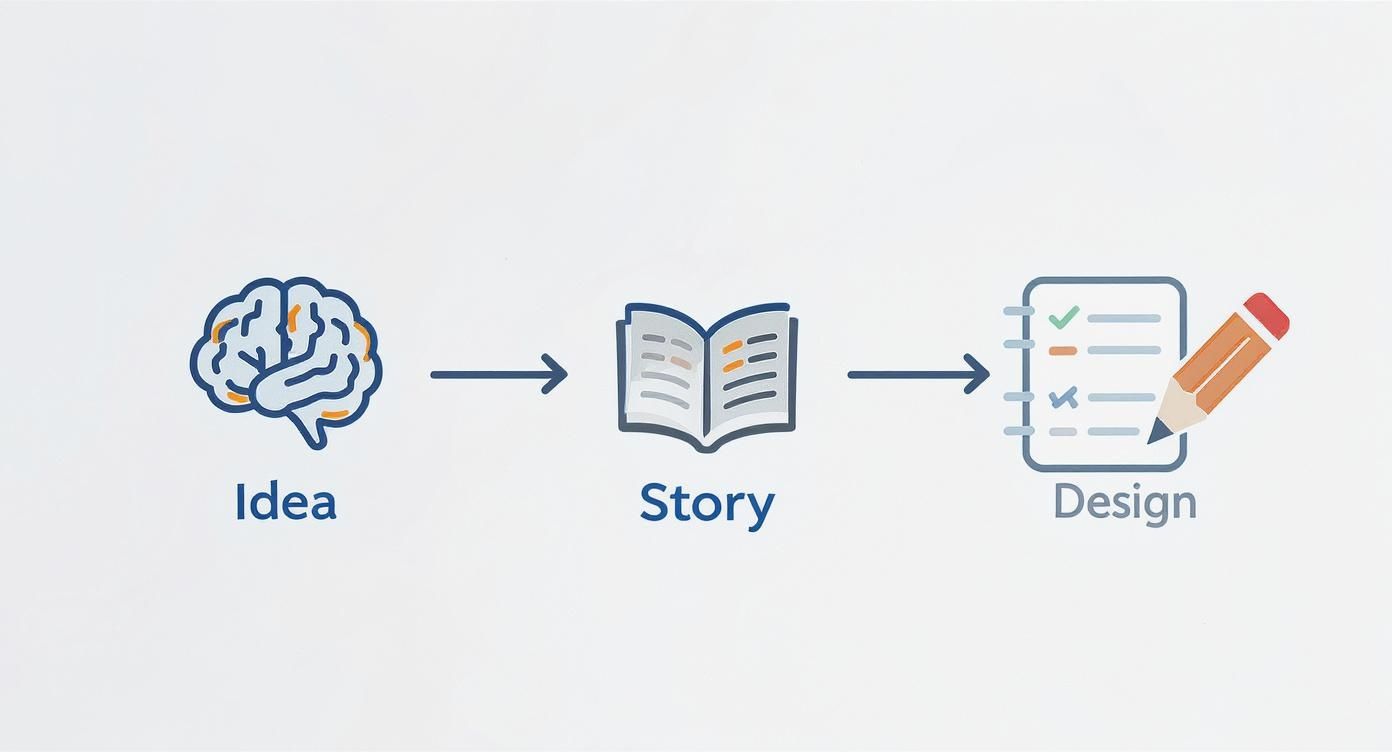
This entire process ensures every visual choice is deliberate and tied directly to the character's identity and narrative role. The objective is not just to create something that looks impressive, but something that feels authentic to the character.
Mastering the Art of Retopology
The high-poly sculpt, with its millions of polygons, is visually stunning but too demanding for a game engine. This is where the technical craft of retopology becomes critical. Retopology is the methodical process of building a clean, efficient, low-polygon mesh over the detailed sculpt.
This new "low-poly" mesh is the asset that will actually be used in the game. The challenge is to preserve the silhouette and key forms of the original sculpt while using a small fraction of the polygons. It is a precise skill, requiring strategic placement of every vertex and edge to ensure the character deforms correctly during animation, especially around complex areas like elbows, knees, and the face.
Retopology is a crucial, often overlooked, aspect of game character design. It is the technical bridge that allows highly detailed art to perform smoothly within the real-time constraints of a game engine.
This principle is evident even in classic games. During the development of Donkey Kong Country, feedback from Nintendo led designer Kevin Bayliss to give Donkey Kong a more distinct, cartoonish appearance. Subsequently, Diddy Kong was created to be noticeably smaller and more agile. This clear visual difference immediately communicates their different gameplay mechanics to the player—a masterclass in how design directly impacts user experience.
Good topology is paramount. Poor topology leads to unnatural deformations during animation and can severely impact game performance. For designers looking to accelerate the early ideation phase, tools like AI character generators are becoming useful for quickly prototyping different looks in both 2D and 3D. This modern approach can free up more time for the crucial technical work, like sculpting and retopology, where an expert human touch remains essential.
Texturing and Material Creation for Realism
A beautifully sculpted model is a significant achievement, but it's incomplete. Without textures and materials, a character is just a digital sculpture—possessing form but lacking life. Texturing is the process of giving surfaces their identity, turning a plain mesh into convincing leather, gleaming metal, or weathered skin.
This stage of the process breathes believability into a character, making them feel tangible within the game world and bringing fine details to life.
Preparing the Canvas with UV Unwrapping
Before any texturing can begin, a crucial technical step is required: UV unwrapping.
Imagine your 3D model as a complex, custom-shaped object that needs to be wrapped. You cannot use a simple flat sheet of paper; you must create a pattern that fits its unique form. UV unwrapping is the digital equivalent. It is the process of flattening your 3D model's surface into a 2D map, known as a UV map.
This map serves as a blueprint, instructing the game engine on how to wrap a 2D texture around the 3D character. Proper execution is vital. A poor unwrap results in stretched, warped, or distorted textures that can compromise an otherwise excellent model. For those new to the concept, it's beneficial to understand what UV mapping is and why it's so important.
Embracing Physically Based Rendering
Modern game art almost exclusively uses a workflow called Physically Based Rendering (PBR). This is an approach that aims to simulate how light interacts with materials in the real world, resulting in stunningly realistic visuals that look correct and consistent under any lighting condition.
Instead of artists faking lighting effects by painting highlights and shadows into a texture, PBR utilizes a specific set of texture maps that define a material’s physical properties. Tools like Adobe Substance Painter have become the industry standard, allowing artists to paint materials like rust, dirt, and fabric directly onto the 3D model in real time.
This screenshot from a Substance 3D guide illustrates how different PBR maps work together to define a surface.

Each sphere highlights a different property, from colour to roughness, showing how PBR creates realistic surfaces by simulating actual light behaviour.
PBR is not just an artistic choice; it’s a technical framework that ensures a character looks correct whether they are under harsh sunlight or next to a flickering torch in a dark environment.
The Essential PBR Texture Maps
The effectiveness of PBR comes from several different texture maps working in concert. Each map is a simple grayscale or colour image that controls a single aspect of the material's surface. Understanding their functions is key to creating any material imaginable.
Here is a summary of the core texture maps used in a PBR pipeline.
Essential PBR Texture Maps Explained
By combining these maps, artists can define almost any material. A single character might use dozens of material sets—one for worn leather boots, another for a coarse woollen tunic, and a third for scarred steel pauldrons. This meticulous work enhances the illusion and makes a character feel truly grounded in their world.
Preparing Your Character for Animation
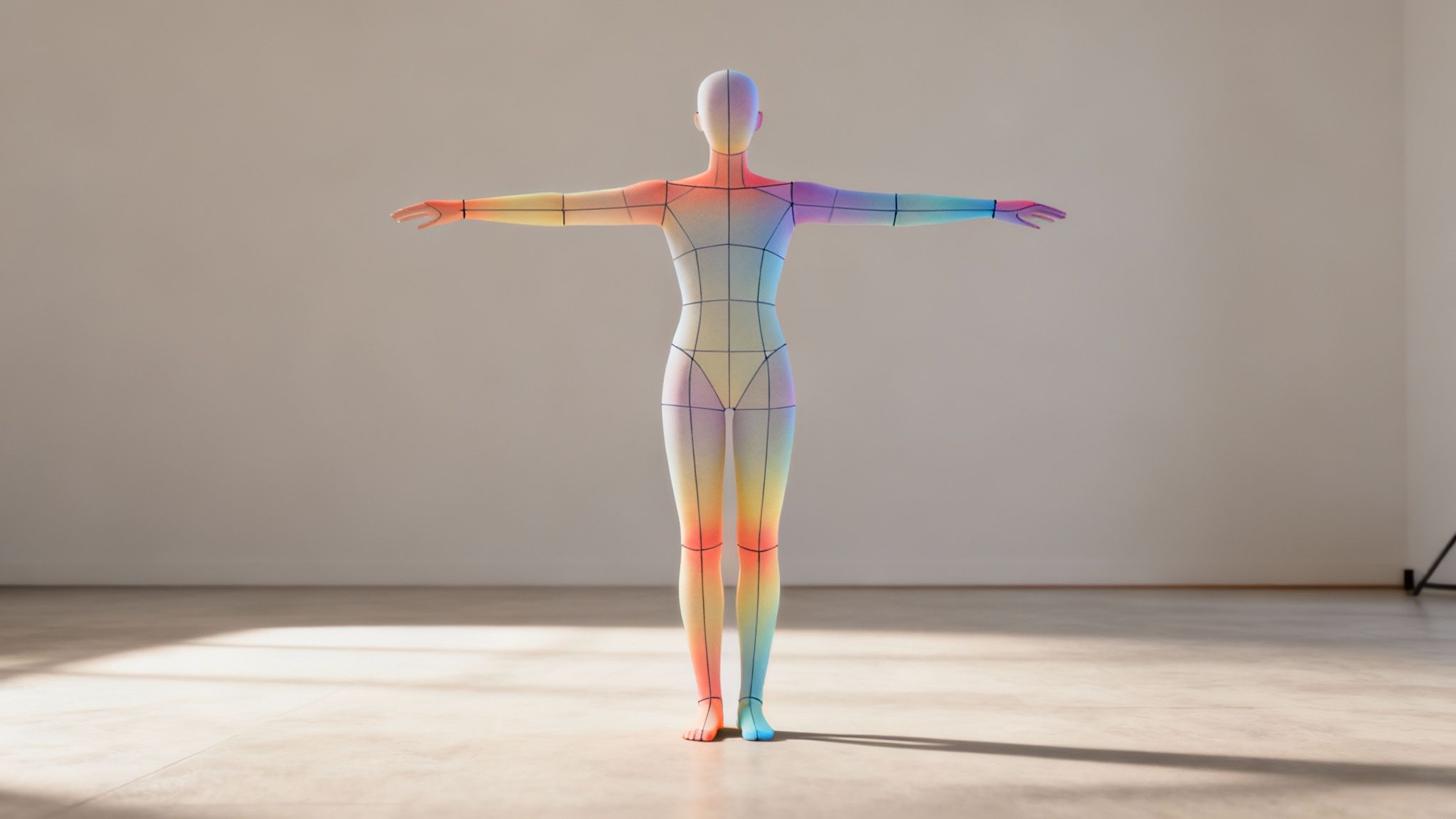
This is the stage where a static 3D model is given the potential for movement. Rigging is the technical process that transforms a lifeless mesh into a digital puppet that an animator can bring to life. A well-constructed rig is the invisible foundation for every jump, punch, and subtle expression in the game.
The core of any rig is its skeleton, a digital framework of joints and controls that mimics a real anatomical structure. A flaw in this stage can lead to unnatural movements, frustrating revisions, and significant delays.
Laying Down the Bones: Skeletons, Joints, and Controls
The process begins by placing joints at all key pivot points—hips, knees, shoulders, elbows—which define the character’s fundamental range of motion.
However, animators do not directly manipulate these raw joints. Instead, a layer of intuitive controls is built on top. These are often simple curves or shapes that provide animators with a clean, straightforward way to pose the character without touching the underlying skeleton. This separation is fundamental to a clean, animator-friendly rig.
To provide maximum flexibility, rigs typically include both FK and IK systems.
- Forward Kinematics (FK) is ideal for broad, arcing motions. For a character swinging their arm, an animator would pose the shoulder, then the elbow, then the wrist in a hierarchical chain.
- Inverse Kinematics (IK) is essential for actions where a limb needs to remain planted. When a character's foot stays locked to the ground during a walk cycle, that is IK at work. A single control at the ankle drives the position of the knee and hip.
Making it Move: Skinning and Weight Painting
Once the skeleton is built, the character’s "skin" (the 3D mesh) must be attached to it. This process is called skinning, and it involves assigning which vertices of the mesh are influenced by which joints.
Most 3D software includes automatic skinning tools that provide a decent starting point, but manual refinement is where the true artistry lies. This is accomplished through weight painting, where influence values are painted directly onto the mesh. Poor weighting is easy to spot—it causes unnatural, rubbery bending at the elbows or pinching at the shoulders.
It is highly recommended to test deformations early and often. Pose the character in a simple squat or have them reach for an object. This helps identify problems much faster.
The goal is to create smooth, believable deformations. For an area like a shoulder, a gradual blend of influence from the clavicle, upper arm, and chest joints is necessary. Achieving this is what distinguishes a professional rig from an amateur one.
Building an Animator-Friendly Rig
A great rig is not just functional; it is efficient and intuitive to use. An animation team should not have to struggle with a clunky or confusing setup. Small details make a significant difference.
- Label everything logically. Ambiguous names like "joint_07_final" should be avoided.
- Colour-code controllers. For example, using blue for all left-side controls and red for the right-side.
- Lock unused attributes. If a control should only translate and not scale, the scale channels should be locked to prevent errors.
An organized, intuitive rig can significantly reduce communication overhead between departments and has been shown to reduce iteration time on projects.
Testing, Finalising, and the Virtuall Advantage
Before handoff, the rig must be thoroughly tested. Create simple walk and run cycles to check for jittering or other anomalies. Test facial controls by transitioning between expressions like a smile and a frown.
Once the rig is approved, it's time for clean-up. Delete any unused nodes and clear the construction history to keep the file size manageable. Finally, export a test version to your game engine to ensure everything looks and behaves as expected.
This is another area where a unified workspace like Virtuall can deliver significant efficiencies. Instead of relying on manual file transfers, a central hub streamlines the process.
- Virtuall’s AI tools can suggest initial skin weight presets based on mesh topology, saving considerable setup time.
- Animators can leave feedback with annotations directly on the 3D model, ensuring clarity and eliminating confusion.
- With one-click exporting to Unity and Unreal Engine, you can be confident that what you see in the workspace is what you will get in the game.
Ultimately, this shortens feedback loops and ensures the character is delivered to animators faster and with fewer technical issues. Your team can focus on creating an amazing performance, not wrestling with a flawed rig.
Optimising Your Character for Game Engines
Once your character is sculpted, textured, and rigged, the final stage is ensuring it functions correctly within a live game engine. This is where artistic creation meets pure technical discipline.
An impressive character model is ineffective if it negatively impacts the frame rate. Optimization is the careful balance between visual fidelity and performance, ensuring the player’s experience is smooth and responsive.
This balance is governed by technical budgets—primarily polygon counts and texture resolutions. A character for a pre-rendered cinematic might have 100,000+ polygons, but a real-time player character often needs to be significantly lower to maintain performance, especially with multiple characters on screen.
Mastering Polygon Counts and Texture Budgets
First, establish clear performance targets.
A common goal for a main character in a modern PC or console game might be around 50,000 to 80,000 triangles. For less important NPCs, this could be as low as 10,000. These figures are determined by the target platform, genre, and the number of assets on screen at once.
Texture resolution follows the same principle. While 4K textures look incredible, they consume significant video memory (VRAM). A typical setup might use one 4K map for the head and another for the body. For smaller props or less visible areas, dropping to 2K or 1K textures can save valuable resources.
The goal is to allocate the "pixel budget" where it will have the most impact. Familiarity with different 3D model file formats and their characteristics also helps in making informed decisions when exporting assets.
Implementing Levels of Detail
A crucial technique for open-world or graphically intensive games is creating Levels of Detail (LODs). An LOD system consists of multiple versions of your character, each with a progressively lower polygon count. The engine automatically swaps between them based on the character's distance from the camera.
- LOD0: The full-quality model, seen up close.
- LOD1: A moderately reduced version, perhaps with 50% fewer polygons, for mid-range viewing.
- LOD2: A heavily simplified model, potentially 75% lower than LOD0, for distant characters.
- LOD3/Impostor: At extreme distances, the character might be replaced by a simple 2D billboard image.
This technique drastically reduces the computational load, as the engine isn't wasting resources rendering millions of polygons for characters the player can barely see.
Creating effective LODs is a skill. The key is to reduce geometry while preserving the character’s core silhouette. When done correctly, the player will never notice the transition.
Beyond static models, managing performance for cinematics is also important. Knowing how to compress video without losing quality is essential for integrating high-fidelity cutscenes without causing stutters or long load times.
Responsible and Inclusive Character Design
Technical optimization is only part of the process. A core responsibility in modern game design is ensuring our creations are inclusive, respectful, and suitable for a global audience. This extends beyond technical specifications to the ethical considerations of our work.
Building safe and welcoming game worlds means being thoughtful about the characters we create. It involves avoiding harmful stereotypes and embracing diverse representation. For example, some studies have noted that female characters in certain fighting games can have a much narrower range of expressions than their male counterparts—a detail that players notice. More insights on how character design choices have real-world repercussions are available for further reading.
This awareness strengthens a studio’s commitment to building positive communities. When you create characters that a wide range of players can identify with, you not only broaden your game’s appeal but also contribute to a healthier, more inclusive industry. This is the final check to ensure your character is not just technically sound, but also thoughtfully and responsibly designed.
Answering Your Top Questions About Game Character Design
As you delve deeper into character design, certain questions frequently arise. Whether you are a student starting out or a professional tackling a new project, clear answers are essential for progress.
This section addresses the most common queries from the creative community, offering practical advice to guide you.
What Software Should I Actually Learn First?
This is a very common question, and the answer is not a single program but a pipeline of tools. To be a versatile character artist today, you need a core toolkit.
- Sculpting: ZBrush remains the industry leader for high-poly work due to its powerful feature set. However, Blender has become a fantastic—and free—alternative that is highly capable.
- Retopology & Modelling: This is for building the clean, animation-ready mesh. The go-to tools are Maya or, again, Blender.
- Texturing: Adobe Substance Painter is the industry standard for modern PBR texturing and is considered essential.
- Game Engines: Comfort in both Unreal Engine and Unity is highly valuable. Studios choose their technology for various reasons, and proficiency in both makes you a more marketable professional.
Avoid trying to master all of these at once, as it can lead to burnout. A recommended approach is to focus on one area, like sculpting in Blender, and develop strong skills. Once you feel confident, move on to the next part of the process, such as texturing.
Seriously, How Much Anatomy Do I Need?
A significant amount. Even when creating highly stylized or cartoonish characters, a solid understanding of anatomy is non-negotiable. It is what makes creations feel grounded and believable.
You need to understand bone structure, major muscle groups, and how they work together to create movement. This knowledge prevents characters from looking stiff or having limbs that bend in unnatural ways. It is the difference between a character that feels alive and one that looks like an inanimate object.
What Makes a Character Portfolio Stand Out?
Your portfolio is your most important professional asset.
Recruiters and art directors prioritize quality over quantity. Instead of showing twenty average pieces, present three to five exceptional, fully finished characters that demonstrate your ability to handle the entire pipeline—from the initial sculpt to the final in-engine presentation.
Do not just show the final rendered image. Include breakdowns of your work. Show your high-poly sculpts, the clean wireframes of your topology, and your detailed texture maps. This proves you understand the technical side of game character design, not just the artistic aspect. It signals to a studio that you can deliver assets that are not only beautiful but also production-ready.
Ready to unify your creative workflow? With Virtuall, your team can generate, manage, and collaborate on 3D models, images, and videos all in one AI-powered workspace. Move from concept to final asset faster than ever before. Start streamlining your creative production with Virtuall today.

